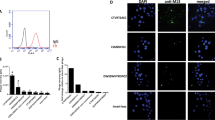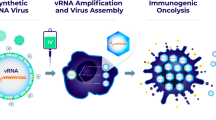Abstract
The ability to specifically target a cell-type is important for the development of vectors for in vivo gene therapy. In order to produce retrovirus vectors targeting ovarian cancer cells, which specifically overexpress α folate receptor (αFR), a single chain antibody was fused as an N-terminal extension of the ecotropic and amphotropic murine leukemia virus (MLV) envelope glycoproteins. Vector particles bearing the modified glycoproteins were produced and analysed. Although conventional FACS studies indicated that viral particles bearing the modified Env could bind to ovarian cancer cells, targeted infection was not achieved. The initial step of virus–cell interaction was further studied using an immunofluorescence technique, which allows visualisation of single retrovirus particles. Vectors bearing chimeric or wild-type glycoproteins bound equally well to cells with or without the targeted receptor, although soluble chimeric glycoproteins bound specifically to FBP. Our results indicate that the incorporation of specific ligands to the virus envelope does not necessarily result in significant enhancement of vector particle binding. A similar interaction was also observed using Env-defective virus particles, suggesting that cellular factors incorporated into the lipid envelope play a dominant role in promoting initial adsorption of virus particles to cells. Significant implications arise from these observations on the interpretation of previous reports on ‘targeted’ vectors, and for the development of vectors for in vivo gene therapy protocols.
This is a preview of subscription content, access via your institution
Access options
Subscribe to this journal
Receive 12 print issues and online access
$259.00 per year
only $21.58 per issue
Buy this article
- Purchase on Springer Link
- Instant access to full article PDF
Prices may be subject to local taxes which are calculated during checkout







Similar content being viewed by others
References
Russell SJ, Cosset FL . Modifying the host range properties of retroviral vectors J Gene Med 1999 1: 300–311
Russell SJ, Hawkins RE, Winter G . Retroviral vectors displaying functional antibody fragments Nucleic Acids Res 1993 21: 1081–1085
Kasahara N, Dozy AM, Kan YW . Tissue-specific targeting of retroviral vectors through ligand–receptor interactions Science 1994 266: 1373–1376
Somia NV, Zoppe M, Verma IM . Generation of targeted retroviral vectors by using single-chain variable fragment: an approach to in vivo gene delivery Proc Natl Acad Sci USA 1995 92: 7570–7574
Han X, Kasahara N, Kan YW . Ligand-directed retroviral targeting of human breast cancer cells Proc Natl Acad Sci USA 1995 92: 9747–9751
Matano T et al. Targeted infection of a retrovirus bearing a CD4-Env chimera into human cells expressing human immunodeficiency virus type 1 J Gen Virol 1995 76: 3165–3169
Cosset FL et al. Retroviral retargeting by envelopes expressing an N-terminal binding domain J Virol 1995 69: 6314–6322
Marin M et al. Targeted infection of human cells via major histocompatibility complex class I molecules by Moloney murine leukemia virus-derived viruses displaying single-chain antibody fragment-envelope fusion proteins J Virol 1996 70: 2957–2962
Konishi H et al. Targeting strategy for gene delivery to carcinoembryonic antigen-producing cancer cells by retrovirus displaying a single-chain variable fragment antibody Hum Gene Ther 1998 9: 235–248
Martin F et al. Retroviral vector targeting to melanoma cells by single-chain antibody incorporation in envelope Hum Gene Ther 1998 9: 737–746
Yajima T et al. Retroviral vector targeting human cells via c-Kit-stem cell factor interaction Hum Gene Ther 1998 9: 779–787
Schnierle BS et al. Expression of chimeric envelope proteins in helper cell lines and integration into Moloney murine leukemia virus particles Gene Therapy 1996 3: 334–342
Benedict CA et al. Targeting retroviral vectors to CD34-expressing cells: binding to CD34 does not catalyze virus-cell fusion Hum Gene Ther 1999 10: 545–557
Chadwick MP et al. Modification of retroviral tropism by display of IGF-I J Mol Biol 1999 285: 485–494
Miotti S et al. Characterization of human ovarian carcinoma-associated antigens defined by novel monoclonal antibodies with tumor-restricted specificity Int J Cancer 1987 39: 297–303
Campbell IG et al. Folate-binding protein is a marker for ovarian cancer Cancer Res 1991 51: 5329–5338
Coney LR et al. Cloning of a tumor-associated antigen: MOv18 and MOv19 antibodies recognize a folate-binding protein Cancer Res 1991 51: 6125–6132
Sudimack J, Lee RJ . Targeted drug delivery via the folate receptor Adv Drug Del Rev 2000 41: 147–162
Douglas JT et al. Targeted gene delivery by tropism-modified adenoviral vectors Nat Biotechnol 1996 14: 1574–1578
Canevari S et al. Regression of advanced ovarian carcinoma by intraperitoneal treatment with autologous T lymphocytes retargeted by a bispecific monoclonal antibody J Natl Cancer Inst 1995 87: 1463–1469
Cosset FL et al. High-titer packaging cells producing recombinant retroviruses resistant to human serum J Virol 1995 69: 7430–7436
Bagnoli M et al. Downmodulation of caveolin-1 expression in human ovarian carcinoma is directly related to alpha-folate receptor overexpression Oncogene 2000 19: 4754–4763
Pizzato M et al. Initial binding of murine leukemia virus particles to cells does not require specific env-receptor interaction J Virol 1999 73: 8599–8611
Valsesia Wittmann S et al. Improvement of retroviral retargeting by using amino acid spacers between an additional binding domain and the N terminus of Moloney murine leukemia virus SU J Virol 1996 70: 2059–2064
Lavillette D et al. A proline-rich motif downstream of the receptor binding domain modulates conformation and fusogenicity of murine retroviral envelopes J Virol 1998 72: 9955–9965
Morling FJ et al. Masking of retroviral envelope functions by oligomerizing polypeptide adaptors Virology 1997 234: 51–61
Ager S et al. Retroviral display of antibody fragments; interdomain spacing strongly influences vector infectivity Hum Gene Ther 1996 7: 2157–2164
Nilson BH et al. Targeting of retroviral vectors through protease–substrate interactions Gene Therapy 1996 3: 280–286
Albritton LM et al. Envelope-binding domain in the cationic amino acid transporter determines the host range of ecotropic murine retroviruses J Virol 1993 67: 2091–2096
Walker SJ et al. Heparin binds to murine leukemia virus and inhibits Env-independent attachment and infection. (Submitted)
Rijnboutt S et al. Endocytosis of GPI-linked membrane folate receptor-alpha J Cell Biol 1996 132: 35–47
Sambrook J, Fritsch EF, Maniatis T . Molecular Cloning A Laboratory Manual, second edn, Cold Spring Harbor Laboratory Press, Cold Spring Harbor 1989
Bottero F et al. Gene transfection and expression of the ovarian carcinoma marker folate binding protein on NIH/3T3 cells increases cell growth in vitro and in vivo Cancer Res 1993 53: 5791–5796
Takeuchi Y et al. Type C retrovirus inactivation by human complement is determined by both the viral genome and the producer cell J Virol 1994 68: 8001–8007
Evans LH et al. A neutralizable epitope common to the envelope glycoproteins of ecotropic, polytropic, xenotropic, and amphotropic murine leukemia viruses J Virol 1990 64: 6176–6183
Acknowledgements
This work was funded by GlaxoWellcome and the Medical Research Council. MP was supported by a EU TMR grant (contr number FMBICT961804). We thank Centocor for provision of Mov18 monoclonal antibody, Dr J Benard for Igrov1 cells, Dr LH Evans for 83A25 rat antibody, and Professor G Palu' for his continued support and interest.
Author information
Authors and Affiliations
Rights and permissions
About this article
Cite this article
Pizzato, M., Blair, E., Fling, M. et al. Evidence for nonspecific adsorption of targeted retrovirus vector particles to cells. Gene Ther 8, 1088–1096 (2001). https://doi.org/10.1038/sj.gt.3301494
Received:
Accepted:
Published:
Issue Date:
DOI: https://doi.org/10.1038/sj.gt.3301494
Keywords
This article is cited by
-
Paclitaxel-loaded phosphonated calixarene nanovesicles as a modular drug delivery platform
Scientific Reports (2016)
-
Shedding of clinical-grade lentiviral vectors is not detected in a gene therapy setting
Gene Therapy (2015)
-
Streptavidin–biotin technology: improvements and innovations in chemical and biological applications
Applied Microbiology and Biotechnology (2013)
-
A mutant retroviral receptor restricts virus superinfection interference and productive infection
Retrovirology (2012)
-
Antitumor efficacy of oncolytic herpes simplex virus adsorbed onto antigen-specific lymphocytes
Cancer Gene Therapy (2012)



